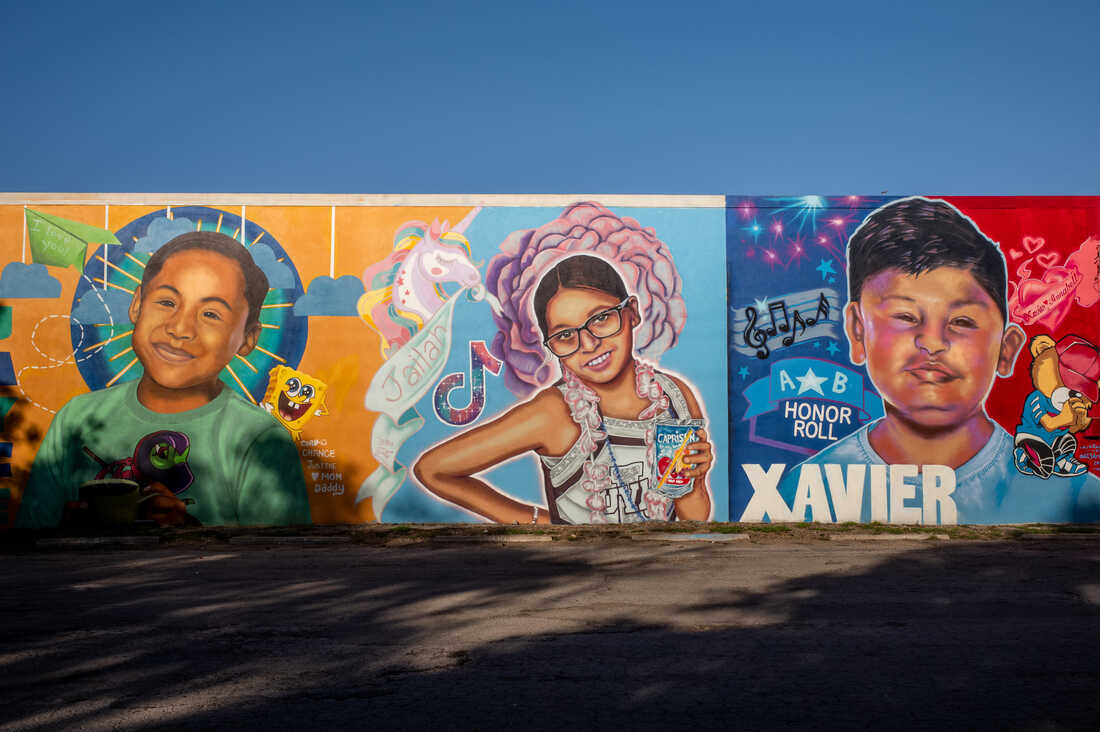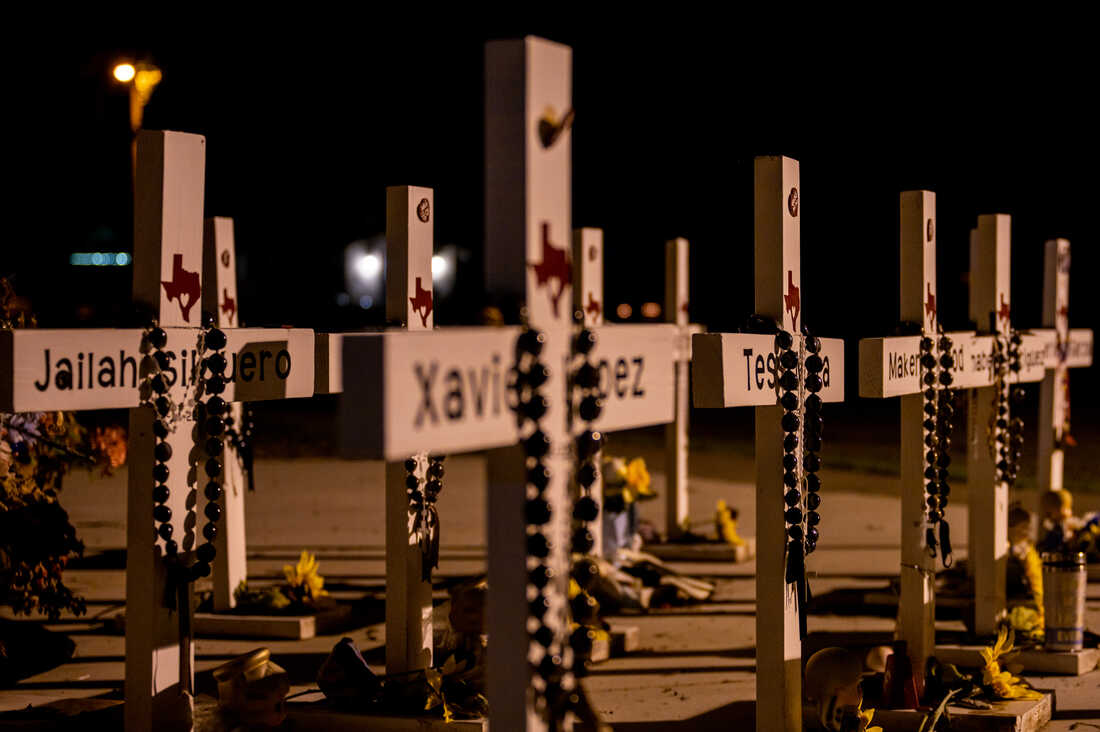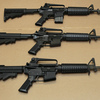Nicole Ogburn says she has been diagnosed with PTSD, anxiety and depression since she survived the school shooting a year ago.
Verónica G. Cárdenas
hide caption
toggle caption
Verónica G. Cárdenas


Nicole Ogburn says she has been diagnosed with PTSD, anxiety and depression since she survived the school shooting a year ago.
Verónica G. Cárdenas
Nicole Ogburn says she wasn’t the kind of teacher she should have been this year.
“But everybody said, ‘Well, what do you expect?’ You know, there’s so many things going through your mind,” she told NPR.
Ogburn said those things frequently included keeping track of items she could use to barricade her classroom door, if what happened a year ago happened again.
“I have a shelf sitting right by the door, kinda like I did at Robb last year,” she said. “I was like, I would push that up against the door and then, I don’t know, stack chairs. A lot of that stuff went through my head all year long – what can we do just to maybe give us a little more time?”
Ogburn is a survivor of the deadly mass shooting at Robb Elementary in Uvalde, Texas. On May 24, 2022, a gunman killed 19 students and two teachers. Ogburn helped her students escape through a bullet-shattered window that day.
The story was brutal enough to rattle a nation that has seemingly grown numb to mass shootings, even in schools. The public was horrified by details like distraught parents trying to enter the building, while police hesitated for more than an hour outside of the classroom before confronting the gunman.
Even as more mass shootings grabbed headlines throughout the year, Uvalde remained a symbol of grief – a community trying to make sense of the violence, remembering the beloved children and teachers while embracing the traumatized survivors.


Murals of Jayce Luevanos, Jailah Silguero and Xavier Lopez are seen in April in Uvalde.
Brandon Bell/Getty Images
hide caption
toggle caption
Brandon Bell/Getty Images
Ogburn wasn’t even sure she could go back to work after the shooting.
“I’ve been diagnosed with PTSD, anxiety, depression, all those things,” she said. “And I just can’t imagine – I’m an adult, I’ve developed some coping mechanisms through my life — I just can’t even imagine, like, as a child that was nine years old that went through this, how they’re coping and moving forward. Not moving on, but moving forward from this.”
Ultimately, the kids were the reason Ogburn returned.
“If I didn’t go back, why would any of the children that were in my class want to go back to school?” she said. “So I had to suck it up and do what I had to do for my family.”
Last August, Ogburn reported for duty at a repurposed campus space, dubbed Uvalde Elementary School. Robb Elementary, the place she’d worked for seven years, was closed after the shooting.
She said she was thrilled to see the children again, and that she still loves her job. But as far as the “suck it up” part? It barely mattered that she was an adult — those coping mechanisms worked overtime all year.
“I’ve had to roll myself out of bed five minutes before I’m supposed to be at work,” she admitted. “Because just that motivation, that desire that I used to have to go to work and teach, it hasn’t been there this year like it had in the past.”
And the exhausting stress didn’t begin or end in her classroom. Or even in the community. News reports of mass shootings around the country continued all year, and a hyper vigilance now follows Ogburn wherever she goes.
“I’ve taken my daughters to the mall in San Antonio, and every time I go, it goes through my mind: OK, if something was to happen, where could we go? Where can we hide? Where could we run to? Where can we shield ourselves from something like this?”
Ogburn was born and raised in Uvalde, and said that even though everyone came together after the tragedy, new tensions had since emerged.
“There was lots of controversy in town and screaming and yelling about things. And it just kind of makes you feel like, OK, no, we’re not strong. This is literally tearing our community apart,” Ogburn said. “Instead of us doing something positive and coming together, it was literally tearing us apart.”


A memorial dedicated to the victims of the shooting.
Brandon Bell/Getty Images
hide caption
toggle caption
Brandon Bell/Getty Images
Monday was the last day of the school year. Ogburn will now perform the annual ritual of cleaning up her classroom: Taking down posters, decorations, art – and this year, packing up a trove of less familiar items. At the start of the school year, while shopping for supplies, she was focused on buying security gear and things to keep her students safe.
“I bought a thing that you jam under the door so that they can’t open the door,” she told NPR at the time. “I bought a curtain to pull down so you can’t see in my door if something was happening. We’ve just thought of more safety this year than how cute my room is going to look.”
Don’t get her wrong, it’s still pretty cute in there. Warm, colorful, creative. “But it wasn’t a top priority.”
As Ogburn and her students navigated normal things like lessons, schedules and supplies, the shadow of their shared trauma loomed. Kids became nervous if they saw something in the hallway, so Ogburn would close that curtain she bought for her door. Law enforcement activity in town would have everyone on edge, even if it wasn’t near the campus. They have more officers from the Department of Public Safety roaming the building.
And of course, there are the safety drills — for those who survived the shooting, not a just-in-case exercise, but a reenactment of what actually happened.
“Sometimes those kids, that’s a trigger for them,” Ogburn said. “Even though they knew it was coming, because every one of our drills this year was actually announced and prepared for before we had it, like a week before.”
And then after the drill is over? After calming down the kids who didn’t take it well – and calming herself, too? “You continue with your day of teaching,” Ogburn said.
And even as her students study their words, one has left her own vocabulary: promise.
“I can’t promise that we’re going to be safe,” she said. “Before, I would tell my kids, ‘We’re safe. I promise.’ I just felt like I can’t make those promises. And so this year it was, ‘We’re safer than we’ve ever been.’ That’s kind of how I put it, just because we had the DPS officers on campus all year long. I didn’t say, ‘I promise we’re safe.'”
This story originally appeared on NPR



